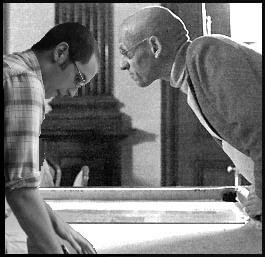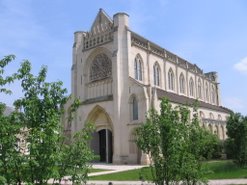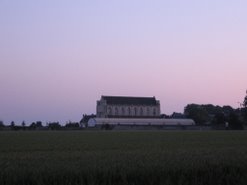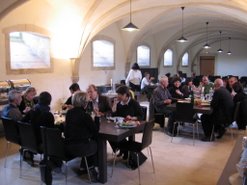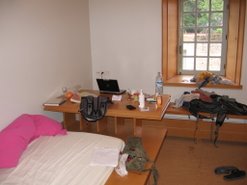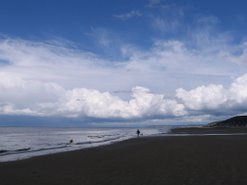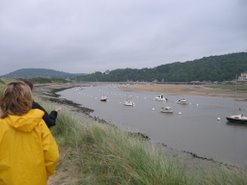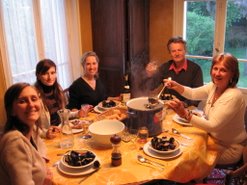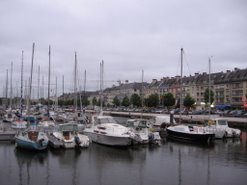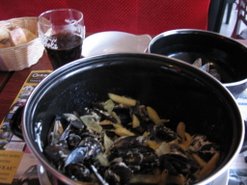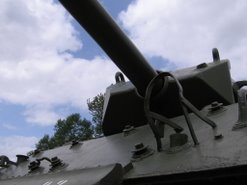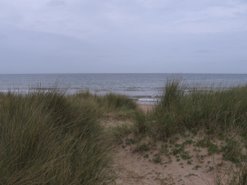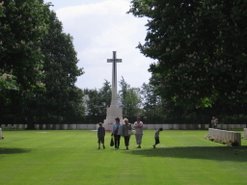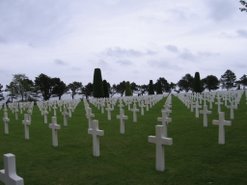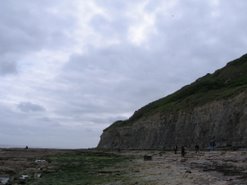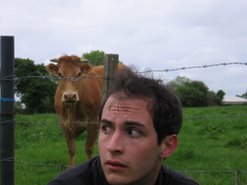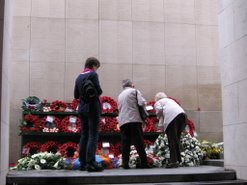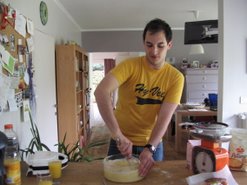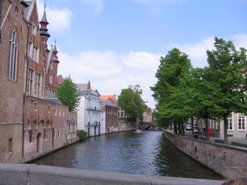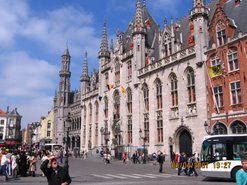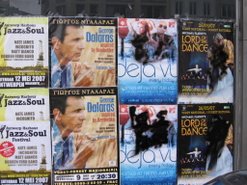MAY 20 - JUNE 1
That Tuesday morning I woke up betimes. I had learned the ins and outs of Caen pretty well already and swiftly made my way to the right bus stop. With correct change ready I boarded and rode out to the abbey. I went in and triumphantly said in French, “my name is Alex I have arrived.” The groundskeeper I spoke to frowned at me, and told me to go to the office. Inside the office I repeated myself, and a woman in the office smiled, and in English asked if I was American. Sheepishly I admitted to being American. She introduced herself as Estelle. She found my dossier, and noted I was from Chicago. She said, “You know, in France we have a stereotype about Chicago?” I asked what it was. “That it’s a city full of murders.” I assured her my existence in Evanston was far from homicide ridden.
Soon she gave me a little bag full of keys. “This one is for the dormitory, this one is for the locker in the dormitory, this if for the library, and this is for the locker in the library…” With hands full of keys I followed her out of the office and into the courtyard.
The abbey was created in the 12th century and until the 20th century its towers were the highest points in Caen. The Nazis used it as an observation post. Before the Allies could take Caen they had to first take the abbey. During my stay here I' ve sometimes bumped into tour groups who are visiting specific war sites and stop into the abbey. I’ve been on an Australian and Canadian tour of the abbey already.
In the course of the war the abbey was destroyed. Since 2000 it has been rebuilt with pains to make it look period. The front courtyard is ringed by two-story buildings with slate roofs; in the middle is a pond with lilies.
In one of these buildings Estelle revealed a fleet of bicycles that are to be used by the scholars if they need to run errands.
As you walk deeper into the compound you first reach a garden, with rows of flowers and a larger array of vegetables and fruit trees. At the far end of the garden is a patio and dozens of deck chairs and recliners.
Opposite the garden is a long stone structure with a red roof, that looks something like a barn, and perhaps at one time it was. Now it is a theater where they host book readings and special performances. Behind this is a large gatehouse in the walls that encircle everything. The gatehouse has a regal appearance with a tiered roof.
Turning right from there Estelle showed me to the dormitories which from the outside look like a medieval stables but houses 15 beautifully modern rooms. Each room has high-speed Internet connection and glass desks for the scholars to work at, not to mention its own private bathroom. I dropped off my bags and followed her down some stairs. Under the rooms was a long dining room with a vaulted ceiling where the meals are served.
We exited the dining hall though a side door and went to the Abbey’s central building, the former church that is now a library. It is a Gothic structure of bright sandstone with a rose window in its front wall and an arched doorway with sculpted entry. Inside, however, three-story high bookshelves have been retrofitted into the interior and long reading desks run the length of the nave. Each is outfitted with computer terminals. Sun pours through the rose window from behind, and if one could continue one's gaze past the apse one could see a vast field of wildflowers. It goes without saying that this is a wonderful place to conduct research. Estelle left me as I stood still in the courtyard with my jaw dropping in amazement.
I re-entered the library and registered with the librarian. She quickly got me set up at a computer terminal where I would have access to all their digitized recordings of Foucault. At that terminal I was confronted with some 300 hours worth of lectures, radio appearances, and public discussions from Foucault’s career. So there I was at table 3. This is where I would stay for the next 2 weeks.
My days took on a sort of pattern. I would wake at 8:30 am and stumble down to a breakfast buffet, I always would have a bowl of granola with a cup of black coffee (really good coffee). Then I would shower and enter the library at 9:30. I would work, half-listening half-writing, until 1pm when the others and I would return to the dining hall. We would then be served a lunch prepared with vegetables and spices from the garden. There was always a cheese course and always a fresh fruit tart. I would sit talking or listening to the French conversations going on around me and by 2 pm I would return to the library and continue my work until 6 pm. I would then take a bicycle and ride into Caen, buy a baguette and cheese and sit near the castle to eat my picnic. At 8 pm I would return to the abbey and work in my room until the sun faded, then slip away into sleep. This was a pattern I quite enjoyed and a way to do 10 hours of work somewhat effortlessly. I focused on lectures from the 1960’s and specifically on lectures delivered in Tunisia.
These days rearranged a lot of my thinking about Foucault; or rather rearranged what I could say about Foucault.)
The other feature of the abbey is the other researchers. It takes a certain sort of person to come to the middle of Normandy to work in an archive dedicated specifically to 20th century French philosophy. There was a young Italian man finishing his dissertation on Foucault’s concept of “Governmentality”. Foucault delivered a series of lectures on the topic at the College de France and the recordings are, of course, here. There was a Finnish woman who lives in Paris but writes for Japanese periodicals. She was working on an article on the presentation of Japanese art in Paris in the 1950’s. She was writing it all in Japanese. Her mastery of language put me to shame. There was a group of scholars who all sat together at one end of the library with their laptops. I found out later they were an economist, a logician and a computer engineer. They were writing a computer program that could understand a particular proof written by the French thinker Claude Barnard. Barnard’s notebooks are all here. This project would be over my head even if explained to me in English. There was also a very kind older French woman. She and I always seemed to sit next to each other at lunch. She would implore me to speak to her in French and then she would try to reply in English, we had about equal mastery of each other's language, and over the course of the week we both improved if only a little. She was going over correspondences from the French anthropologist Claude Levi-Bruel. She would vehemently say in French and English he was really a philosopher but never gets the credit and is always demoted to an anthropologist, no offense to anthropologists. However, I spent much of my free time with an Austrian doctoral student who was finishing a Biography of Sarah Kofman.
Sarah Kofman was a Polish Jew who at the time of the Holocaust was only a little girl. She was smuggled into Paris and hidden for the duration of the war by a Parisian woman. She eventually went on to become a professor of philosophy, and an important theorist for those who know about her. And to make it a small world she was the mentor of my advisor at Northwestern, Penelope Deutscher. So, in a way, I see myself in a pedagogic lineage extending from Kofman.
As a scholar she is best known for her critiques of Nietzsche and Freud. Her writing is highly contemplative and often poetic. Perhaps her most published work is an autobiographical text of her time hiding in Nazi occupied Paris called Rue Ordener, Rue Labat. This refers to the two streets between which she hid. She recounts the capture of her father, the curious anti-semitism of her French protector and the custody dispute for Sarah between her protector and her real mother after the war. Together with her critiques of Freud and Nietzsche her work articulates, my Austrian friend argued, “a pitiless ethic of mercy”. I like the way that sounds.
There was also another American, a PHD from Notre Dame. She, like me, was here on a scholarship and enjoying the vast resources of the American private universities. This became a topic of discussion one night, about how in comparison such a venture would be both difficult and unlikely for a French student. As the conversation dwindled the student from Notre Dame asked innocently, “what was this place [the abbey] originally made for” to which she got the quick response, “for American students to come on scholarships of course.” And a great roar of laughter went up. Although I got the joke, I think it would have had more bite if I truly understood the particular ethos and pathos (perhaps more pathos) of the French University system.
One night the Austrian, and the other American joined me on my bike ride into town. We sat and chatted at a café and ate some Kebab’s. I showed off and spoke Turkish to the men working at the Kebab shop. Karoline, the Austrian girl, left early to get back to the abbey for the evening. There was to be a presentation by a well known, although still unknown to me, French mystery writer. I decided my French wasn’t up to the task so Jennifer from Notre Dame I and stayed in the city and walked around until dusk.
When we arrived back at the Abbey it was abuzz with activity. The parking lot was full and the theater doors were open and people milled about smoking and talking. Whoever this writer was he was a big draw. The French love their roman policier, as my mom would say. I made a cup of tea and fell asleep before the crowd had even left the compound.
Earlier in the week I had been online and happened to chat with an old friend named Elodie. She was an exchange student from France to Northwestern when I was a freshman. Through a curious social network she became a close friend of my close friends and eventually we got to know each other. When in Chicago I was the only one willing to visit historical sites with her. We both have fond memories of our day going on the Frank Lloyd Wright walking tour. After she left we kept in touch. A few years later we happened to exchange e-mails and found out we would be in Turkey at the same time. We met up again in Izmir for a few days. And now, a few years later I show up in France. She was surprised to learn I was in France and even more surprised that I was in Caen. She said her whole family was coming down to Normandy for a holiday weekend and she invited me to join them. The archive closed on the weekend and it sounded like a lovely idea.
Her family has a house in Cabourg. Cabourg is of significance for Proust lovers. He spent many years here and was perhaps it’s most famous invalid when he convalesced in Cabourg’s Grand Hotel. In his novels the town takes the name Balbec, and close study will reveal the inspiration for his work in the streets of this small Norman town. Elodie told me people all pretend to read Proust, but in reality he is too dense and no one has ever finished one of his novels. I’m guilty of the same crime.
Cabourg was a very fashionable city in the 30’s and 40’s and became more so when France passed the 35 hour work-week laws and the legislation to require paid vacations. It is one of the closest swimming beaches (weather permitting) to Paris. You can tell that it once had a bourgeois existence. Most of the houses are huge, but of a bygone era. One can see lane after lane of very tall and narrow houses with fading paint and old woodwork. In more recent decades Cabourg has become more middle-class, and the very chic high-class have moved to Deauville just a few kilometers to the northeast. Deauville is now famous for it’s “American Film Festival.” If you visit Deauville you can see changing houses on the beach with the names of their owners printed on them like, “Clint Eastwood” or “Tom Hanks”. Nothing like this in exists in Cabourg just “Proust”. Elodie said she preferred Cabourg and its slower pace and truer Norman charm.
On Friday after the library shut it’s doors I jumped on a shuttle provided by the abbey to the train station, said my goodbyes to all my new scholarly friends I had met at the abbey, and walked to the bus station. There was much hugging and kissing and exchanging of e-mails.
Normandy really only has one train track. This is an exaggeration but it seems to be true. There is one line that runs from Paris to Cherbourg, and if you want to visit somewhere off that route you have to take regional busses. Cabourg has a train station but there is only one train a week that arrives on Friday night and leaves on Sunday morning. The bus ride was about half and hour and I arrived in Cabourg in the early evening. Elodie and family were not leaving Paris until 8:00 pm and we had arranged to meet at a local bar when they arrived in Normandy around 10:00.
I spent a good while walking along the beach. This was a much different vista from the one I'd had at Omaha. The cliffs were a long way off and the beach was wide and sandy, not narrow and pebbly. Many couples walked up and down the beach holding each other by the waist and bracing themselves against the occasional strong gust of wind. In the far distance I could see windsurfers.
I passed the Grand Hotel and made a call to my parents in the plaza in front of it. As I was talking to my parents, three French boys, not older than 11 or 12, decked out in hip hop regalia, and riding 10 speed bikes, rode into the plaza. The first kid who had gelled and spiked up hair went into an adjacent phone booth. He picked up the phone and started loudly saying, “EH EH I’M SPEAKING ENGLISH” at which his two sidekicks giggled uncontrollably. This didn’t get any reaction from me. So the kid started smearing his face against the glass of the phone booth. Again, this elicited no reaction from me, just the giggles of his cronies. He disappeared around a corner and then returned to stand in my line of sight and make faces. I looked right through him. Then, in a moment of desperation he picked up a handful of stones and threw them at the booth. They hit loudly, but didn’t faze me. Shortly after, all three were chucking stones at the glass booth. I didn’t know if the phrase about stones and glass houses could be translated, so I kept right on talking to my parents. Completely baffled by my composure even after the bombardment the three picked up their mountain bikes and peddled off quietly. I felt both sides in our confrontation were unsure about who won, or even what the terms of engagement were.
I spent the next long while fruitlessly looking for an open wireless network. But for the first time since I'd landed in Europe I came up unconnected. So I went to the appointed bar and waited, reading some Foucault and drinking a coke. After dusk Elodie appeared dressed in her summer togs. We hugged and kissed cheeks four times. Elodie introduced me to a friend she had also invited to join us, and informed me that another friend would be arriving the next day. They all attended the Science Po, the university all French students who want to be politicians must attend, (most analogous to Georgetown, but even more necessary if you want to be in government) everyone, that is, except Sarkozy.
Elodie and her friend Mathilde, however, have no intention of holding public office. Elodie, although she studied in the department of “contemporary political dilemmas” is bound for big business. She already works for L’Oreal and has been accepted into the best graduate program for business in France (very much the Kellogg of France). Mathilde, on the other hand, studies national defense, and is already interning with a defense contractor. That weekend she was dreading having to write a brief on terrorists and money laundering. The two of them gave me one more piece in my still developing picture of the French educational system and the educated class.
Elodie's parents had gone right to the beach house to sleep, but we kids stayed out until 2:00 am talking. Elodie had, of course, studied in America and Mathilde had lived a year in Australia, so out of convenience the conversation was all in English. It was funny to listen to their two distinct accents when they spoke, as they had each learned English in very different parts of the world. We talked about Foucault, and how rarely he is mentioned in French universities, as compared to Anglophone universities where he is not always studied but often given lip service. We talked about globalization and how amazing it is that Elodie and I have met on three continents. This led to a debate on Cosmopolitanism and how Kant’s idea of a universal citizenship is hindered by current class struggles. We inevitably talked about the recent presidential elections in France.
France had an 85% voter turnout. Elodie and Mathilde were proud of this fact, and saw it as a mark of a working democracy. They spoke about the build up to the election as a very consuming period. Everyone talked about it, everyone had an opinion, and it was the single most unifying topic they can remember. It was interesting to listen to how they told the story of the left versus the right in France and what kind of historical perspective they deemed relevant. 1968 came up, but perhaps the Mitterrand years loomed the largest in the history of the rifts within the French left.
They described the election as being a choice between two bad candidates. Both were leading parties that are deeply fractured, and politically scattered. I said, “well that sounds like an American presidential elections,” but in the conversations to come in the weekend that followed, I took it back. The factors at play cannot be reduced to a comparison to the American two-party system.
Tired and talked out we walked through the misty late-night streets of Cabourg to Elodie’s house. It was one of these tall narrow houses circa 1920. It had been in her family for that long.
Elodie apologized for the interior decorations before we even entered. Inside the house there were lots of bright floral wallpapers and every surface had little toys or collectable objects. In one corner there was an elephant’s foot made into an umbrella stand and a large tortoise shell hung on the wall like a painting. I assured her I loved the decoration. I imagined this to be a wonderful place to visit as a kid. Every room was full of curiosities and the house seemed to imply secret passages and hidden magic. Elodie showed me to my bedroom, which displayed several cases of pinned butterflies and a diorama of plastic cowboys and Indians having a shoot out, while on the opposite wall was a glass case with little lead Napoleonic troops marching in formation. It is nice to stay in a place that has the residue of four generations of kids.
The next day we all slept in. When we awoke breakfast was waiting for us on the table. Over breakfast we somehow began discussing race politics in America. I always feel if an awkward position when abroad. My American-ness makes me the most immediate expert on the topic, and I do have my opinions on race in America, but I am far from qualified to speak on it. I always feel a little phony. What I generally speak about is my own experience growing up in an overwhelmingly white rural town and that this fact tells a story of segregation in its own right. It did not happen this morning, but at other times I’ve been asked, “If black men are your NBA stars, why do you put them in prison?” It is a naive but also profound question that I have no idea how to answer.
After we showered Elodies parents return from a walk proclaiming the dunes to be particularly beautiful this morning. And as soon as breakfast was cleared we all sat down to lunch. The first course was shrimps with just a little lemon and pepper, I was instructed to eat the head and all. They were fabulous. Over lunch I described my work at the archives. Elodie's mom perked up, and explained that she had attended Michel Foucault’s lectures when he taught at the College de France. She said he was a very great speaker, and that she and her friends would suspend themselves from windowsill just to see him in the over crowded amphitheater. We were able to converse in English and Elodie was pleasantly surprised with how well her mother was speaking. Apparently she hasn’t studied English since her university days, but has recently gotten back into it by watching reruns of "Friends".
For the main course we had chicken and ratatouille. Obviously, this was followed by cheese…and desert…and fruit…and coffee. I asked if Elodie’s family always eats this well, and her mother laughed heartily and said of course, “I have two teenage sons back in Paris and I know how to feed young men.” Over cheese, Elodie’s father enquired about my grant and nodded approvingly. Whereas Elodie’s mother was lively and boisterous father was a quiet and kindly man. Together they made a lovely combination. He and I never engaged in any long conversations but in the course of the weekend spent long times reading in each other's company. Both he and I liked to mark in the margins of our books, and so we would sit on opposite ends of the living room below the tortoise shell, glasses on the edge of our noses, chuckling to ourselves and scratching notes into our books.
After lunch Elodie, Mathilde, and I went for a short walk on the much-acclaimed dunes. We bounded on the sand and I explained my profound love for Jacque Tati films to the general confusion of the girls.
Shortly we returned, jumped in the car and drove to Deauville to pick up the third of Elodie's friends at the train station. A construction detour took us off the coastal road and into the country. It was great to be amidst peers and friends, driving and listening to music. The two motivating forces in my life are foreign travel and time with friends, yet sometimes these work against each other. Usually one can stay put with friends or travel alone, but when the two coincide, as they did this weekend, it’s a wonderful thing.
Ann-Laure was waiting for us at the station in Deauville. She had studied a year at the University of Chicago and had nearly perfect English. We put her bags in the car and walked to the beach. Elodie pointed out the chic boutiques and pricey restaurants, as compared to the one sleepy commercial street of Cabourg with its modest bars and tabacs. The girls went into a shoe store, and got themselves some new high heels. Admittedly Deaville still has its attractions.
We walked the regionally famous boardwalk, and saw all the stars' names printed on the changing-houses. I was able to talk at length with Ann-Laure about her time in Chicago. She had studied sociology and wanted to continue it when she returned to France, but the pressure to find a good job and to use her Science Po diploma for either business or politics was too compelling. So she has begun working at BMG, but still has a soft place in her heart reserved for sociology and scholarly study.
Mussels were on the menu for that evening so Elodie's mother had called to have us fetch a bottle of white wine for the broth. After much discussion about which would be the best wine in which to cook mussels, and much counseling from the clerk at the wine store, we finally settled on a bottle.
We then stopped into a lovely bakery to buy cakes as a gift for our kind hosts. We got an assortment of pastries put into a little pink box and topped with a bow. While the clerk was curling the bow, I drifted into my own thoughts. I had a staggering realization of the complexity of the moment I found myself in. For no apparent reason I fixated on the many forces that had to coalesce to make it possible. The flour had to get to the bakery that morning and a factory had to make ribbons available in a country with a stable currency. The fact that this simple transaction was even happening felt impossible against all the contingencies that would have to occur for it to happen. A rational mind can admit to this complexity, but it was an entirely different thing to feel it.
It made me think back to the library I visited in Dar es Salaam where books sat unsorted in a building without lights. Then I compared this to the temperature-controlled library in Caen with its army of trained archivists. Before leaving I got myself a large pastry ball covered in chocolate chips. The girls informed me that when they were kids this was usually called a “nigger’s head”. And it all came crashing back on me. From hearing this racially loaded name the whole seemingly perfect system took on a different tone. If you consider the perfection of the French bakery and revel in how it all works, then be reminded that these systems function parallel to or as a result of racism, then the bakery becomes an intense space for an intersection of history and of culture. I became mesmerized by and frightened of the dessert I was about to eat.
My pensiveness was cut short as we stopped halfway to Cabourg to rendezvous with Mathilde’s extended family who were vacationing just outside of Deauville. We stopped at a café and I was introduced to a handful of cousins and relatives. Most of the conversation fell to the girls and their plans for the near future. What their work would be and the like. I was asked about my research and about my hometown in Minnesota.
One member of the group asked if when I go back to Minnesota people will see me as too educated. I was startled by the question. I told him that there are a lot of scholars where I come from, and to be honest, I have never considered education as a condition of social stratification in my life. This answer was both shocking to them, and to me. I can, of course, see how education can be socially dividing, but it had never entered my imagination in this way. Perhaps this is my naiveté as the privileged recipient of a long and liberal education. I might have told a very different story if I didn’t have all the educational opportunities I’ve had. And in a weird way this social blind spot of mine and my casual ignorance of it reminded me of the casualness with which I was introduced to the “niggers head”.
The conversation went on without me and the sun broke out in the gray Norman sky. When my thoughts reemerged into the present the bill was being paid up and we were off to Cabourg again. We all read in the living room until dinner was put steaming on the table. We each devoured our mussels by the plateful.
As the meal ended and coffee was being served a playful game of “who has a more interesting history” began. Anne-Laure said America only has the revolution and the civil war. I said France only has its revolution and Napolean. We agreed to share WWII. I was asked to tell the story of the Mayflower. It is one of those things we forget is so particular to American culture. These facets of our history are not common knowledge. I in turn asked them to tell the story of the beginning of the Frankish kings. Elodie’s mom couldn’t stop laughing at this absurd battle of who had the better history.
After dinner we four kids returned to the bar I had waited at the previous night. As we walked Elodie asked us brainteasers. Both she and Anne-Laure in the course of going to corporate interviews have been asked lots of logic questions. It evolved into an addiction and we spent most of the night with scraps of paper in the bar working out each other’s logic puzzles. We entertained ourselves like this until 3 am. Somehow Sarkozy, Foucault, or history never came up.
The next day was a lazy one. We slept in. Then we woke up and read. Elodie prepared for a Portuguese exam. At midday Anne-Laure caught the weekly train leaving Cabourg, and that evening Mathilde rode back to Paris with her relatives. Before we all scattered we walked the streets of Cabourg one last time. The city had organized a small jazz festival, and on each corner of its little commercial street was a different jazz ensemble. People were out walking in the rare sunny afternoon eating ice cream and listening to music. Just as we were leaving rain began to fall but the jazz continued. I was a little worried that the saxophones would rust. When Elodie took Anne-Laure to the train the sun reemerged and Math and I went to the beach, but underestimated the speed of the approaching dark clouds and got completely soaked in the biggest downpour of the weekend. We walked in a sopping mess to the pitying merriment of Elodie’s parents who rushed us into dry towels.
That night the Barbey’s and I spent a quiet evening at our computers reading and writing. The next morning we had breakfast and parted ways promising to see each other in Paris. I went to the bus stop I had arrived at two days before and waited. A few kids were also waiting and I asked what time the bus would arrive. Everyone was confused. This day was actually the Pentecost, which is traditionally a holiday in France, but a new law had made it a working day for the first time this year. So we didn’t know if the bus was running on a regular Monday schedule or an irregular holiday schedule. I decided to walk back towards the town to the tourist information. They were equally confused but finally surmised that it would be on the holiday schedule. I wasn’t so sure so I waited for 1 pm for the normal bus. But nothing came. That seemed to be proof that the busses were on holiday schedule. So I returned for the Bus at 2 pm. No bus. By this time a few other people had gathered at the stop. When the bus was 20 minutes late. One of them called the bus company. She was informed that the drivers were on strike.
There was only one train from Cabourg and that was yesterday. The only link between the Norman cities was this bus, and it was on strike. I had to get to the abbey to register for the coming week and my options were dwindling. I considered hitching, but eventually was convinced by a fellow bus patron to split a cab back to Caen. He had to get to a business meeting for which he was now an hour late. I obliged and he called several taxis. Most were unwilling to come out to Cabourg. Finally he found a local one and we took the short 20-minute ride to Caen. Even after splitting it, it cost me 40 euro, and I’ve now come to realize one must always budget a little extra time and money in Europe in anticipation of strikes. Clearly I shall never forget the French word for strike, “une greve”, as it has twice changed the course of my life.
Back at the abbey everything was the same. Same work to be done, same schedule in which to do it. It rained in the evenings that week and I wasn’t able to get into the city on my bike as much as I had intended. The biggest difference was in the new scholars who arrived.
There was an American professor from Michigan who was working on contemporary French poetry and a Canadian journalist who is writing a book on 19th century newspaper illustrators (we had a lot to talk about). There was a Belgian girl working on the COBRA art movement. There was also a Polish student from Princeton writing a history of Catholic thought in post-Soviet Poland. Apparently there are some relevant correspondences housed here in Caen.
One of the sunny evenings I biked into the city and to the train station. I purchased my one-way ticket for Paris. I was then committed to the next leg of my adventure. From here it is on to the Museums of Paris and whatever fortunes may befall me.
Travel blog of Alex as he combs Eurasia in search of trouble and the lost lectures of Foucault.
Thursday, June 14, 2007
Monday, June 4, 2007
Paris -> Caen -> Bayeux ->Caen
May 15 - May 22
I left Belgium with a new reverence for labor unions. I had just spent two days visiting the post office trying to retrieve a letter from America. It arrived just as the Belgian postal delivery personnel went on strike. The tellers at the offices were not on strike so when I arrived at the post office, I was greeted by a deeply bored window teller. I was told in half-Flemish, half-English, that the letters were not moving but that I was welcome to buy stamps.
It was explained to me that the all the letters were gathering in the office to languish in sacks unsorted and untouched. I was also told that the Pentecost was happening this weekend, and it was unlikely the strike would end or mail move before the holiday. I was cheerily informed I would have my letter in no less than a week. A letter that was in the same building I was in. It was all so matter-of-fact that I could do little else then shrug and thank them for the inconvenience.
Instead of languishing like the letters I decided to take a bus to France and seek my adventures elsewhere. The bus was to leave from a corner just outside of Ghent’s train station but there were no sign or marks to confirm this fact. People with baggage began to gather on the corner. They all looked equally bewildered. Everyone eyed everyone else looking for clues that someone else was planning to take a bus, checking to see if someone’s luggage looked like it was going to France or if a bus ticket was sticking out of a pocket.
I broke the silence and asked a girl (who looked about my age) in the clumsy Dutch I had learned, if she was also waiting for the bus to Paris. She replied, “Oh I’m sorry I don’t speak Flemish.” I told her I didn’t really either and asked again in English. She was waiting for the same bus, so I put down my pack and prepared to wait. In idle conversation I learned that she was an exchange student from Spain, actually a Basque. She was en route to spend her holiday weekend in Paris.
I had her give me a basic grammar lesson in Basque, and soon the Bus arrived. The ride to France was uneventful. I slept mostly or talked to the Basque student across the aisle. I asked her about secession, and she just laughed.
In Paris I wasted no time and went from the bus stop to Gare St. Lazare. I arrived with about half an hour to spare before I had to board my train to Normandy. I had intended to arrive in Caen and look for a hostel, but I decided I should call ahead. I had written down the name of a few hostels. I called them only to be informed that they were all closed until June. Some of the hostels were hostile and abruptly hung up on me. Others laughed when I suggested that they let me stay anyway, promising I would wash dishes.
Every 20 minutes Gare St. Lazare is the site of a very strange ritual. Train platforms are not announced until just before the train departs. So people gather at a large central mechanized board that, at the appropriate time, tells them what platform to go to. You can see hundreds of people, open-mouthed, craning their necks in perfect unison to see the board flash. They look like a large troop of meerkats all surveying the same spot on the horizon. The board flashed platform 19 for the train to Caen, and I and several hundred others grabbed our bags and rushed to get a good seat on the train. Then the quietly observant meerkats turned into a stampede of buffalos.
A bit dazed and confused within the swarm of people, I somehow made it into a seat. The train ride was even less eventful than my ride to Paris, as I slept soundly nearlythe entire way with my face against the window. The few times I awoke I noticed the rolling hills of northwest France broken by the occasional village church steeple. In these moments I sometimes imagined myself a medieval pilgrim walking on foot from small town to small town on my way to Avignon or Turin or some other famed pilgrimage destination. I imagined what they must have felt when, after long days of walking, they saw a steeple on the horizon with all the promise of hospitality and rest. It was marvelous to see the dot of the steeple become a town as I got closer. A few days later, when I rented a bicycle I would think of this again as, tired and thirsty, I would focus on just getting to the next steeple.
Once in Caen I was not totally willing to accept that all the hostels were closed. I walked to the tourist office and was again informed they do not open until June 1st. While I was there I grabbed a map and a list of hotels and began to walk. I must have walked the entirety of the town in the next two hours, pausing only to sit in bus shelters to wait for the periodic evening showers to pass. Each hotel I went to left me feeling I could find better. Unsuccessful in finding a room, and a little soggy I passed a side street not far from the tourist office where I had begun. There, tucked behind a Chinese restaurant, was a little hotel. Yellow light glowed from the windows in the dusk. I tromped in and in my burgeoning French asked to see a room.
The clerk was kindly and spoke clearly and slowly to me. After he showed me a nice blue room, we returned to the reception desk and I took it. I conducted the whole affair in French, including small talk about the weather. This was a major triumph for me, as I really had only been forced to speak French for a day. I got a kebab at a snack shop around the corner and went to bed early.
In many ways I was unprepared for my trip to Normandy. I knew there was an archive I had to get to, but I didn’t know where it was. I knew there was some material in the archive that I needed, but I didn’t know how much there was or how long it would take me to work through it. I knew there was a holiday weekend in Belgium but didn’t realize it was also in France. So when I woke the next morning I was informed that everything was closed, the buses were not running, and no one had ever heard of the archive.
I decided to stay another night in the hotel and spend my day finding the archive. A map at the bus stop provided the general direction I wanted to go and identified a region of the city that shared the same name as the archive, “Ardenne”. So I set off, umbrella in hand, into the gray morning. Norman weather is not known for its pleasantness or permanence. It is often raining and always changing. Painters have commented on the wonders of the thousand different grays in the skies of Normandy (that’s what I call finding a silver lining). For my part I did enjoy the swirling clouds and breaks of light in the sky, but also feared the next downpour.
My walk took me over even more of the city than my hunt for a hotel had. Caen is an old city and was an important administrative city for William the Conqueror in the 11th century. Several ecclesiastical structures and the better part of a castle still exist from that time within the center of the city. Many structures have been extensively rebuild, either by later French monarchs for their own reasons or after being ruined in the Second World War. The Nazi’s held Caen unexpectedly long after the Normandy invasion. As a result of allied bombing and German attempts to sabotage anything usable, the city was pretty well destroyed. As for the 11th century monasteries and churches, they were the only things open in the city. While I could not find a place to buy bread I could find lots of elderly woman in prayer.
I crisscrossed the city and eventually arrived at the edges of Caen. I decided to push on into the area I assumed to have the archive. I ended up in the middle of a field and had to back track. I tried again only to end up in the playground for a housing complex. It wasn’t until my third return to the city limits and my third plunge into the periphery that I finally saw the archive. The sun was out and I could see a lovely gothic structure beyond a field of yellow wildflowers. The archive is housed in a 13th century monastic abbey. I walked along a country path until I reached its walls. At the corner of this property is a commemorative legend dedicated to Canadian soldiers who died in the battle for Caen. Of course the abbey and the archive were closed and I found myself having to decide between scaling its 20-foot walls and returning to my hotel room. I decided against the wall climb but looked forward with great anticipation to the time I could enter by the door on Tuesday.
I had hoped to make arrangements to work at the archive that day. Instead I e-mailed my contact there and arranged for my arrival after the holiday weekend. So I then had four days in Normandy to kill until I could begin my work. I walked home in the rain wondering what I could do. I arrived back at the hotel at 8 o’clock and realized I had been continually walking for about 10 hours. I fell fast asleep after devouring a block of cheese and a bag of peanuts I had saved from the day before.
The next day the sun was shining although grey clouds crowded the horizon. I decided to spend another day in Caen. Certain shops were open again and I got some groceries. I was also delighted to find out that the local art museum was open.
I must say it is a treat for an art lover to visit a regional art museum of France. It’s not because they house masterpieces, but precisely because they do not. The Caen museum has a wonderful selection of art collected in the Caen region since 1400. What I had come to realize is that the majority of art is really…how do I put it…bad. I saw room after room of oriental scenes of harems from the 18th century and room after room of dark still lives of bread and fruit from the 16th century. All of them were stiff, poorly executed, or just plain weird.
At one level this makes my appreciation for “masterpieces” that much greater. It becomes clear that there is really something exceptional about Raphael or Goya or Degas, when you compare them to their contemporaries, which a museum like this allows me to do. I await with greater anticipation my time in Paris and the Louvre where such singular masterpieces really do hang. On another level, the mediocre works of art are a fascinating representation of the material world, of a history of what we own. It tells a story of what people possessed and what possessed people. For instance, what really compelled anyone to commission a 6-foot circular canvas of bathing cupids in 18th century Caen. If one is to consider a history of taste (which I think is an interesting thing to ponder) one cannot miss a museums like this.
From there I made my way beyond the castle to the north of the city and to the campus of the University of Caen. There was some activity. The campus looks as if it was constructed circa 1970 with a lot of concrete in a sort of formalist design. Box like buildings have names like “science” or “letters” in big block letters above the doors. A handful of student stood smoking outside one of the slab concrete building, which housed a little café that sold 1-euro coffees, the cheapest I’ve found.
In the midst of all this concrete is a small glass building and inside it is a true curiosity. A history professor from Caen spent most of his life creating a scale model of Rome at the time of Constantine. The city is nearly complete and all rendered in plaster. The whole thing fills a the floor of a large atrium with an observation deck above so you can see the details of the city from above. This bizarre labor of love sits quietly without much notice from the passing students. I spent a long time staring at the thing. After a while I returned to the café and spent the rest of the day and into the evening writing. I was tempted to spark up conversations with some of the students working in the café, but was still too shy about my French. For dinner I bought a baguette and some duck liver paté and ate in my hotel.
The next morning I checked out early. I had decided to spend the remainder of the weekend in Bayeux. Bayeux is famous for housing the Bayeux tapestry. The train was only 20 minutes from Caen. The day was sunny and warm. Again I went to the tourist office, and again I was told there are no hostels. I thanked them and took a list of hotels. Tucked in one corner in a section for rooms to rent was a small notice for 12-euro rooms. I thought it was worth a shot and I walked across town to the address in the pamphlet.
I arrived at an 18th century manor house. It was three stories tall with somewhat neglected but still presentable formal gardens. After passing the creaking gate I could hear “Johnny B Good” being played loudly from a ground floor window. I went to the door and knocked. No answer, just music. I knocked again. Unsure if anyone heard me I turned towards the gardens to look for another door. Just as I did the door swung open and an old woman not much taller than my chest peeked out. I explained I was looking for a room. She apologized she didn’t speak much English, but still continued to speak in English even after I told her she could speak French.
She brought me into the front hall. The place was as I would have imagined Miss Havisham’s to be. It had a cracked marble floor, lots of fake flowers and multiple staircases going in various directions. She explained that she normally doesn’t rent for a short term, and she normally doesn’t rent to only one person, but that she liked my face. She looked into my eyes and said and took my hand and said, for you “15 euro”. I agreed. I was too mystified to haggle. “Ok, but come at 6 I will make your bed.”, she said. I agreed to return later and went into Bayeux.
A few scattered posters advertised “A night of museums”. Apparently all across Europe museums were going to open in the evening free of admission. Although I wasn’t in a city where I could take advantage full of this and enter the grand and famous museums of the continent, it would permit me to see the famous Bayeux tapestry for free. I just had to wait until 8 o’clock.
In the meantime, I got some bread and some fruit, some cheese and some juice and sat in a park near the massive Bayeux cathedral. This was an important cathedral for William the conqueror and it was the place for which the Bayeux tapestry was created. I was really hoping to bump into fellow tourists. But the town was still sleepy and the only travelers I noted were French. I still didn’t have the courage to abuse them with my terrible French.
In the later afternoon I walked out to the edge of town and visited the cemetery for British soldiers who died in the Normandy invasion. It was a modest plot with a modest monument. The most interesting part was observing the variety of crests on the head stones. Each unit has it’s own insignia, some of which are very intricate, and these images were carved into the marble crosses for each known dead soldier. The missing and unknown soldiers were commemorated with a miniature Greek temple.
Just alongside this memorial was a second memorial dedicated to Journalists who have died in the line of duty. It was tucked away out of sight from the road and was very hard to identify. I walked the length of the memorial, which consisted of a row of menhirs on a well-groomed garden path. On the pillars were printed names and dates. I noticed the names were obviously foreign and saw some that were clearly Japanese and clearly Turkish. I was totally lost as to their significance. The whole row ended with a horizontal pillar with a quote from Simone de Beauvoir about the virtue of liberty, a quote so general I was left even more confused. It wasn’t until I returned to the road and saw a road sign pointing to the Journalists cemetery that I figured it out. I felt it was a necessary memorial.
I returned to the house at 6:00. Again I knocked but got no answer. After a long while the landlady poked her head out of a 4th story window, and said, “I come.” After another long while, whilst she descended all those stairs, the door opened and she beckoned me in kissing me on both cheeks. We climbed slowly up several flights of stairs past walls densely hung with paintings and dusty crystal vases on marble tables. On the top floor I was shown into a small apartment. I had a kitchen a bathroom and a TV with rabbit ears. She asked me to help her tuck in my bed, as she was unable to bend over. From her pocket she produced a large iron key. It could have been a prop used in “key to the city” ceremony, but it was really for the front door. She wished me a good night and shook my hand vigorously. I listened to her steps descend the several flights of stairs and disappear into the depths of the manor. And with that, and to all intents and purposes, I had just rented a French manor for 15 euros.
I splashed some water on my face and headed back to town. The key made a loud clanking noise in the lock box and worked only after significant jiggling. It lay heavily in my pocket and one could distinctly see the huge outline of a key in my pants. I made my way to the tapestry museum.
The Bayeux tapestry was commissioned by the Bishop of Bayeux to commemorate the events of the battle of Hastings. The majority of the tapestry really has to do with the lengthy build up to the invasion and only the last few panels are the battle itself and the conquest of England. It was to be shown every year for 20 days in the cathedral. It is in many ways a pre-modern comic strip. The tapestry is only half a meter tall but runs horizontally for dozens of meters, and would have wrapped around the interior perimeter of the church. Its use was for nothing less than to educate the illiterate. Here we see that the visual has a long history of being used as a political tool for popular indoctrination. Now it lives in a former government building in a specially designed room inside a massive horseshoe shaped glass case.
The story is not purely self evident from the images themselves, and so it would have to have been shown with instruction from the clergy. As for the modern viewer you get a little hand held audio device with which to hear a recording of a man with a strong British accent telling the story while gothic music plays behind him. Occasionally there are sound effects of horses galloping and or swords clanking. Instead of bringing the story alive for me this device and these sounds had the opposite effect of poignantly reminding me that I was living in 2007 and that I was temporally distant from the tapestry.
The narration focused on the central panels, there were also bands of highly detailed images on the top and bottom of the tapestry. They were images of animals in the forest men in the fields. I was once read a book about the complex relationship between image and border image in gothic graphics, a topic about which I am by no means an expert. The author was interested in how these smaller, sometimes unnoticed border images actually change the meaning of the central images. In the middle of the tapestry there are two border images that stick out as totally incongruous with the rest. The first is of a naked man rendered in black wool with a giant penis pointing to the earth while his hands are on his hips. The next is of a hunched man who grips an axe. He too has a huge penis but it is rendered in red wool. The image above these border scenes if of a faceless woman, clearly noble, standing in a doorway. The audio device did not mention the penises or identify the woman. I’m not even sure where to find out about these truly bizarre images. The guard at the end of the tapestry suggested I go to the gift shop. But I sincerely doubt they have a book on the genitals of the Bayeaux tapestry. Perhaps I’ll take this up as a doctoral thesis.
There was still daylight and time in the “night of museums” to see another. So I walked back out towards the British cemetery to the Bayeux D-Day museum. I was hoping to see artifacts or unique objects from the invasion, but by and large the museum was just kiosks with written information on the invasion in French and English. It was kind of like walking though an encyclopedia article on Normandy 1944. They had a few uniforms from the various armies, and a room of rusting jeeps. The most interesting was a description of how the allies outfitted tanks for hedgerow combat. They had amazing pictures of soldier welding German anti-landing craft obstacles onto the front of US tanks. It gave the tanks giant teeth to crash into and tear up hedges with. These metal obstacles had once been used to block a water landing, each looks like giant jax, but now they were being appropriated to demolish field positions. There is something both poetic and sinister in this reversal of function
I got out of there pretty quickly and walked home listening to Frankenstein on audio book. I had never read it before and was surprised how much I liked it. I stayed up most of the night in the old mansion listening to the story. Just as news of the monster’s first victim developed in the story it started to rain and a wind blew through the big mansion. I am not ashamed to say I hid under my covers for a good 20 minutes.
For those who have not read, or have not read it recently, I was interested to mark the Turkish characters in the novel. There is a lecherous old Turk who betrays a young French nobleman and gets him banished, and a beautiful but dim Turkish girl who is slow in learning French (slower than even the monster!). Perhaps these characters were representative of the European sense of the concept of “oriental”.
The next morning was beautiful despite the rain the previous night. I slipped out of the house as quietly as I could which meant creaking on every step and clanging the key in door. I walked to the center of Bayeaux and rented a bicycle for the day. My goal was to reach Omaha Beach. I wasn’t exactly sure how far it was but it seemed reasonable based on the rough map on the back of the brochure for the tapestry museum. I had not been on a long bike ride for quite some time, and I became reacquainted with many muscles with which I had lost touch.
In reality it was quite lovely. I biked north of Bayeux towards the sea and through country roads that ran along green pastures. It was definitely spring and flocks of sheep and herds of cattle were everywhere, with their new lambs and calves. There is a reason the Christian tradition uses lambs as the ultimate metaphor for innocence. Until you’ve seen lambs bounding in the field, you have not seen youth and innocence (calves not so much). And despite my estrangement from own body and continually being out of breath I really enjoyed my ride. Just at the point I needed a cold bottle of water I arrived in Port-en-Bessin. This small port granted me my first glimpse of the English Channel.
It was market day and I walked my bike past the stands of fresh fruit and cheese. There was a woman roasting rabbits and a man slicing huge manhole cover-sized flounders. I walked through the crowd and onto the wharf. On either side I could see the fortress-like cliffs of Normandy. It was low tide and kids scurried along the dark rocks collecting white shells. It was getting gray again, but it didn’t feel like rain. It just felt like Normandy reminding itself to become grayer.
On the wharf a portly Frenchman in an actual beret asked me if I was Canadian, English, or American. I said American. In broken English he said “just go tout droit et voila Omaha.” Curiously, the way he pointed would have also taken me to Omaha Nebraska. He just wanted to help, and I’m sure he would have pointed me in the right direction for whatever national cemetery I wanted. It must be curious to live in a place where the major economy is death tourism. I thanked him and headed tout droit.
I passed dozens of campgrounds, and wished that the weather would warm up and that I had my own tent so that I could go camping. The ride to Omaha beach was easy, except for some near misses as I and two cars tried to negotiate for lane space on very narrow Norman roads.
I was hoping to run into my countrymen at the cemetery but upon arrival I saw only Japanese tour groups. Where the British cemetery was modest the American cemetery was dramatic. At first glance the field of white headstones has the appearance of going on forever. In reality it’s thousands of headstone arranged in symmetrical lines around two intersecting paths. When peering down these incredibly long rows of white crosses the eyes play weird tricks. Some appear to bend and the rows intersect like elements in a stark white kaleidoscope.
It is a staggering sight. I couldn’t tell if the Japanese tourists had a sense of its enormity for they still took pictures with smiling faces and their fingers forming peace signs. (Which is perhaps profound irony or brilliant transgression). Or perhaps they are like anyone on vacation, not too worried about atrocity.
I ate lunch propped up against my bike. I made a picnic of water and fruit and cheese I got from the market in Port-en-Bessin. After lunch I decided to descend the cliff and set foot on the beach itself.
On the way down I gave most of my attention to placing my foot on the steeply inclined path. But when I emerged on the beachhead I was caught in a stillness. Down a ways on the beach kids were flying a kite and people were in the far distance, but I felt quite alone. Turning around to see from where I just came it was hard to understand how anyone would plunge headlong into that beach while German gunfire rained down. At the trenches of Ierper and the Cliffs at Normandy I was struck by the idea of “the push”. It is a far more complicated phenomenon than either desiring to serve or not to serve. It is a far more complicated decision than to simply obey or disobey. And it cannot be reduced to clear choices on the part of the individual soldier. It would seem to me (as detached as I am) it is more like being caught like a deer in the headlights. The moment the whistle blew to go over the top at Ieper or when the landing craft opened at Omaha each soldier must have experienced a moment of stillness (like the one I was having that afternoon).
I biked straight back to Bayeux. By this time it was already late in the afternoon. I stopped only briefly to catch my breath and watch the ships come into dock at Port-en-Bessin. I returned my bike and walked back to the manor. I was asleep even before the sun set.
The next morning I slept in. I showered and dressed leisurely. As I was leaving my hostess emerged and wished me well on my journeys, I returned the anvil/key. I noticed that yet again everything was closed, and that yet another holiday had sneaked up on me. The train to Caen still ran regularly, but I was unable to find a baguette for brunch.
In the depot a group of middle-aged Americans were sitting around chatting. I had finally met my countrymen, but I decided to keep quiet. For some reason my desire to meet English speakers that had flavored the whole previous weekend left me as soon as an opportunity presented. They chatted about the breakfast at the hotel, and how long the train was, and how sad the cemetery was, and butchered the pronunciation of a few French place names. The train came soon after, and in the short 20-minute ride to Caen I remained in earshot of the Americans. They were going to Caen to see Caen’s D-day museum (not to be confused with Bayeux’s D-day museum). Another traveler was sitting opposite them reading a biography of Hitler in English. One of the American’s turned to him and asked, “Is that interesting?” The man with the biography did not reply.
Just as we reached Caen I reached down into my bag and pulled out my worn tourist map of the city. I tapped one of the Americans on the shoulder and offered it to him. He thanked me, and that was that. I somehow felt satisfied.
Once in Caen I returned to the hotel I’d stayed at previously, only to find them full, as was every hotel I visited. I followed the same crisscrossing path across the city I had the previous week, and like the previous week I could find no free rooms.
One place said they could offer me a room at 6:00 if someone didn’t show up for their reservation. So I went and did my laundray in a little Laundromat near the yacht harbor. It oddly had wireless. So I sat and wrote e-mails and searched for a hotel on line while an old French woman watched me intently as she waited for her clothes to dry. I don’t think she knew exactly what I was doing.
Apparently May is the month of long weekends in France and I was arriving on the last day of a 4-day weekend during which most of Paris had made its way to Normandy. Finally, at a hotel I had already been to, the clerk took pity on my and gave me a room with three beds at the price of one person. I decided to sleep on the leftmost bed.
That evening, a bit exhausted and wet from the day’s rain, I decided to treat myself to a restaurant meal. So I ambled into a corner bar and ordered moule frites, or mussels with fries. This is a particular favorite of mine. It was only 8:00 and I felt very American as I was the only one eating. But, it was great. The inside of mussels look extraterrestrial, but they taste delicious. I got them in a cream sauce. The best part is dunking the fries in the sauce and having them soak up all the juices. When they are plump with cream it’s a beautiful thing. I stayed on and had a coffee and read a bit.
The waiter was very kind to me all evening, permitting my French faux pas and being generally pleasant. I must say, the people I have met in Normandy have been very kind, whether a strange old woman with her mansion or construction workers I asked for directions. I’m warned by the same nice people in Normandy that this will not be true in Paris. We will see.
I left Belgium with a new reverence for labor unions. I had just spent two days visiting the post office trying to retrieve a letter from America. It arrived just as the Belgian postal delivery personnel went on strike. The tellers at the offices were not on strike so when I arrived at the post office, I was greeted by a deeply bored window teller. I was told in half-Flemish, half-English, that the letters were not moving but that I was welcome to buy stamps.
It was explained to me that the all the letters were gathering in the office to languish in sacks unsorted and untouched. I was also told that the Pentecost was happening this weekend, and it was unlikely the strike would end or mail move before the holiday. I was cheerily informed I would have my letter in no less than a week. A letter that was in the same building I was in. It was all so matter-of-fact that I could do little else then shrug and thank them for the inconvenience.
Instead of languishing like the letters I decided to take a bus to France and seek my adventures elsewhere. The bus was to leave from a corner just outside of Ghent’s train station but there were no sign or marks to confirm this fact. People with baggage began to gather on the corner. They all looked equally bewildered. Everyone eyed everyone else looking for clues that someone else was planning to take a bus, checking to see if someone’s luggage looked like it was going to France or if a bus ticket was sticking out of a pocket.
I broke the silence and asked a girl (who looked about my age) in the clumsy Dutch I had learned, if she was also waiting for the bus to Paris. She replied, “Oh I’m sorry I don’t speak Flemish.” I told her I didn’t really either and asked again in English. She was waiting for the same bus, so I put down my pack and prepared to wait. In idle conversation I learned that she was an exchange student from Spain, actually a Basque. She was en route to spend her holiday weekend in Paris.
I had her give me a basic grammar lesson in Basque, and soon the Bus arrived. The ride to France was uneventful. I slept mostly or talked to the Basque student across the aisle. I asked her about secession, and she just laughed.
In Paris I wasted no time and went from the bus stop to Gare St. Lazare. I arrived with about half an hour to spare before I had to board my train to Normandy. I had intended to arrive in Caen and look for a hostel, but I decided I should call ahead. I had written down the name of a few hostels. I called them only to be informed that they were all closed until June. Some of the hostels were hostile and abruptly hung up on me. Others laughed when I suggested that they let me stay anyway, promising I would wash dishes.
Every 20 minutes Gare St. Lazare is the site of a very strange ritual. Train platforms are not announced until just before the train departs. So people gather at a large central mechanized board that, at the appropriate time, tells them what platform to go to. You can see hundreds of people, open-mouthed, craning their necks in perfect unison to see the board flash. They look like a large troop of meerkats all surveying the same spot on the horizon. The board flashed platform 19 for the train to Caen, and I and several hundred others grabbed our bags and rushed to get a good seat on the train. Then the quietly observant meerkats turned into a stampede of buffalos.
A bit dazed and confused within the swarm of people, I somehow made it into a seat. The train ride was even less eventful than my ride to Paris, as I slept soundly nearlythe entire way with my face against the window. The few times I awoke I noticed the rolling hills of northwest France broken by the occasional village church steeple. In these moments I sometimes imagined myself a medieval pilgrim walking on foot from small town to small town on my way to Avignon or Turin or some other famed pilgrimage destination. I imagined what they must have felt when, after long days of walking, they saw a steeple on the horizon with all the promise of hospitality and rest. It was marvelous to see the dot of the steeple become a town as I got closer. A few days later, when I rented a bicycle I would think of this again as, tired and thirsty, I would focus on just getting to the next steeple.
Once in Caen I was not totally willing to accept that all the hostels were closed. I walked to the tourist office and was again informed they do not open until June 1st. While I was there I grabbed a map and a list of hotels and began to walk. I must have walked the entirety of the town in the next two hours, pausing only to sit in bus shelters to wait for the periodic evening showers to pass. Each hotel I went to left me feeling I could find better. Unsuccessful in finding a room, and a little soggy I passed a side street not far from the tourist office where I had begun. There, tucked behind a Chinese restaurant, was a little hotel. Yellow light glowed from the windows in the dusk. I tromped in and in my burgeoning French asked to see a room.
The clerk was kindly and spoke clearly and slowly to me. After he showed me a nice blue room, we returned to the reception desk and I took it. I conducted the whole affair in French, including small talk about the weather. This was a major triumph for me, as I really had only been forced to speak French for a day. I got a kebab at a snack shop around the corner and went to bed early.
In many ways I was unprepared for my trip to Normandy. I knew there was an archive I had to get to, but I didn’t know where it was. I knew there was some material in the archive that I needed, but I didn’t know how much there was or how long it would take me to work through it. I knew there was a holiday weekend in Belgium but didn’t realize it was also in France. So when I woke the next morning I was informed that everything was closed, the buses were not running, and no one had ever heard of the archive.
I decided to stay another night in the hotel and spend my day finding the archive. A map at the bus stop provided the general direction I wanted to go and identified a region of the city that shared the same name as the archive, “Ardenne”. So I set off, umbrella in hand, into the gray morning. Norman weather is not known for its pleasantness or permanence. It is often raining and always changing. Painters have commented on the wonders of the thousand different grays in the skies of Normandy (that’s what I call finding a silver lining). For my part I did enjoy the swirling clouds and breaks of light in the sky, but also feared the next downpour.
My walk took me over even more of the city than my hunt for a hotel had. Caen is an old city and was an important administrative city for William the Conqueror in the 11th century. Several ecclesiastical structures and the better part of a castle still exist from that time within the center of the city. Many structures have been extensively rebuild, either by later French monarchs for their own reasons or after being ruined in the Second World War. The Nazi’s held Caen unexpectedly long after the Normandy invasion. As a result of allied bombing and German attempts to sabotage anything usable, the city was pretty well destroyed. As for the 11th century monasteries and churches, they were the only things open in the city. While I could not find a place to buy bread I could find lots of elderly woman in prayer.
I crisscrossed the city and eventually arrived at the edges of Caen. I decided to push on into the area I assumed to have the archive. I ended up in the middle of a field and had to back track. I tried again only to end up in the playground for a housing complex. It wasn’t until my third return to the city limits and my third plunge into the periphery that I finally saw the archive. The sun was out and I could see a lovely gothic structure beyond a field of yellow wildflowers. The archive is housed in a 13th century monastic abbey. I walked along a country path until I reached its walls. At the corner of this property is a commemorative legend dedicated to Canadian soldiers who died in the battle for Caen. Of course the abbey and the archive were closed and I found myself having to decide between scaling its 20-foot walls and returning to my hotel room. I decided against the wall climb but looked forward with great anticipation to the time I could enter by the door on Tuesday.
I had hoped to make arrangements to work at the archive that day. Instead I e-mailed my contact there and arranged for my arrival after the holiday weekend. So I then had four days in Normandy to kill until I could begin my work. I walked home in the rain wondering what I could do. I arrived back at the hotel at 8 o’clock and realized I had been continually walking for about 10 hours. I fell fast asleep after devouring a block of cheese and a bag of peanuts I had saved from the day before.
The next day the sun was shining although grey clouds crowded the horizon. I decided to spend another day in Caen. Certain shops were open again and I got some groceries. I was also delighted to find out that the local art museum was open.
I must say it is a treat for an art lover to visit a regional art museum of France. It’s not because they house masterpieces, but precisely because they do not. The Caen museum has a wonderful selection of art collected in the Caen region since 1400. What I had come to realize is that the majority of art is really…how do I put it…bad. I saw room after room of oriental scenes of harems from the 18th century and room after room of dark still lives of bread and fruit from the 16th century. All of them were stiff, poorly executed, or just plain weird.
At one level this makes my appreciation for “masterpieces” that much greater. It becomes clear that there is really something exceptional about Raphael or Goya or Degas, when you compare them to their contemporaries, which a museum like this allows me to do. I await with greater anticipation my time in Paris and the Louvre where such singular masterpieces really do hang. On another level, the mediocre works of art are a fascinating representation of the material world, of a history of what we own. It tells a story of what people possessed and what possessed people. For instance, what really compelled anyone to commission a 6-foot circular canvas of bathing cupids in 18th century Caen. If one is to consider a history of taste (which I think is an interesting thing to ponder) one cannot miss a museums like this.
From there I made my way beyond the castle to the north of the city and to the campus of the University of Caen. There was some activity. The campus looks as if it was constructed circa 1970 with a lot of concrete in a sort of formalist design. Box like buildings have names like “science” or “letters” in big block letters above the doors. A handful of student stood smoking outside one of the slab concrete building, which housed a little café that sold 1-euro coffees, the cheapest I’ve found.
In the midst of all this concrete is a small glass building and inside it is a true curiosity. A history professor from Caen spent most of his life creating a scale model of Rome at the time of Constantine. The city is nearly complete and all rendered in plaster. The whole thing fills a the floor of a large atrium with an observation deck above so you can see the details of the city from above. This bizarre labor of love sits quietly without much notice from the passing students. I spent a long time staring at the thing. After a while I returned to the café and spent the rest of the day and into the evening writing. I was tempted to spark up conversations with some of the students working in the café, but was still too shy about my French. For dinner I bought a baguette and some duck liver paté and ate in my hotel.
The next morning I checked out early. I had decided to spend the remainder of the weekend in Bayeux. Bayeux is famous for housing the Bayeux tapestry. The train was only 20 minutes from Caen. The day was sunny and warm. Again I went to the tourist office, and again I was told there are no hostels. I thanked them and took a list of hotels. Tucked in one corner in a section for rooms to rent was a small notice for 12-euro rooms. I thought it was worth a shot and I walked across town to the address in the pamphlet.
I arrived at an 18th century manor house. It was three stories tall with somewhat neglected but still presentable formal gardens. After passing the creaking gate I could hear “Johnny B Good” being played loudly from a ground floor window. I went to the door and knocked. No answer, just music. I knocked again. Unsure if anyone heard me I turned towards the gardens to look for another door. Just as I did the door swung open and an old woman not much taller than my chest peeked out. I explained I was looking for a room. She apologized she didn’t speak much English, but still continued to speak in English even after I told her she could speak French.
She brought me into the front hall. The place was as I would have imagined Miss Havisham’s to be. It had a cracked marble floor, lots of fake flowers and multiple staircases going in various directions. She explained that she normally doesn’t rent for a short term, and she normally doesn’t rent to only one person, but that she liked my face. She looked into my eyes and said and took my hand and said, for you “15 euro”. I agreed. I was too mystified to haggle. “Ok, but come at 6 I will make your bed.”, she said. I agreed to return later and went into Bayeux.
A few scattered posters advertised “A night of museums”. Apparently all across Europe museums were going to open in the evening free of admission. Although I wasn’t in a city where I could take advantage full of this and enter the grand and famous museums of the continent, it would permit me to see the famous Bayeux tapestry for free. I just had to wait until 8 o’clock.
In the meantime, I got some bread and some fruit, some cheese and some juice and sat in a park near the massive Bayeux cathedral. This was an important cathedral for William the conqueror and it was the place for which the Bayeux tapestry was created. I was really hoping to bump into fellow tourists. But the town was still sleepy and the only travelers I noted were French. I still didn’t have the courage to abuse them with my terrible French.
In the later afternoon I walked out to the edge of town and visited the cemetery for British soldiers who died in the Normandy invasion. It was a modest plot with a modest monument. The most interesting part was observing the variety of crests on the head stones. Each unit has it’s own insignia, some of which are very intricate, and these images were carved into the marble crosses for each known dead soldier. The missing and unknown soldiers were commemorated with a miniature Greek temple.
Just alongside this memorial was a second memorial dedicated to Journalists who have died in the line of duty. It was tucked away out of sight from the road and was very hard to identify. I walked the length of the memorial, which consisted of a row of menhirs on a well-groomed garden path. On the pillars were printed names and dates. I noticed the names were obviously foreign and saw some that were clearly Japanese and clearly Turkish. I was totally lost as to their significance. The whole row ended with a horizontal pillar with a quote from Simone de Beauvoir about the virtue of liberty, a quote so general I was left even more confused. It wasn’t until I returned to the road and saw a road sign pointing to the Journalists cemetery that I figured it out. I felt it was a necessary memorial.
I returned to the house at 6:00. Again I knocked but got no answer. After a long while the landlady poked her head out of a 4th story window, and said, “I come.” After another long while, whilst she descended all those stairs, the door opened and she beckoned me in kissing me on both cheeks. We climbed slowly up several flights of stairs past walls densely hung with paintings and dusty crystal vases on marble tables. On the top floor I was shown into a small apartment. I had a kitchen a bathroom and a TV with rabbit ears. She asked me to help her tuck in my bed, as she was unable to bend over. From her pocket she produced a large iron key. It could have been a prop used in “key to the city” ceremony, but it was really for the front door. She wished me a good night and shook my hand vigorously. I listened to her steps descend the several flights of stairs and disappear into the depths of the manor. And with that, and to all intents and purposes, I had just rented a French manor for 15 euros.
I splashed some water on my face and headed back to town. The key made a loud clanking noise in the lock box and worked only after significant jiggling. It lay heavily in my pocket and one could distinctly see the huge outline of a key in my pants. I made my way to the tapestry museum.
The Bayeux tapestry was commissioned by the Bishop of Bayeux to commemorate the events of the battle of Hastings. The majority of the tapestry really has to do with the lengthy build up to the invasion and only the last few panels are the battle itself and the conquest of England. It was to be shown every year for 20 days in the cathedral. It is in many ways a pre-modern comic strip. The tapestry is only half a meter tall but runs horizontally for dozens of meters, and would have wrapped around the interior perimeter of the church. Its use was for nothing less than to educate the illiterate. Here we see that the visual has a long history of being used as a political tool for popular indoctrination. Now it lives in a former government building in a specially designed room inside a massive horseshoe shaped glass case.
The story is not purely self evident from the images themselves, and so it would have to have been shown with instruction from the clergy. As for the modern viewer you get a little hand held audio device with which to hear a recording of a man with a strong British accent telling the story while gothic music plays behind him. Occasionally there are sound effects of horses galloping and or swords clanking. Instead of bringing the story alive for me this device and these sounds had the opposite effect of poignantly reminding me that I was living in 2007 and that I was temporally distant from the tapestry.
The narration focused on the central panels, there were also bands of highly detailed images on the top and bottom of the tapestry. They were images of animals in the forest men in the fields. I was once read a book about the complex relationship between image and border image in gothic graphics, a topic about which I am by no means an expert. The author was interested in how these smaller, sometimes unnoticed border images actually change the meaning of the central images. In the middle of the tapestry there are two border images that stick out as totally incongruous with the rest. The first is of a naked man rendered in black wool with a giant penis pointing to the earth while his hands are on his hips. The next is of a hunched man who grips an axe. He too has a huge penis but it is rendered in red wool. The image above these border scenes if of a faceless woman, clearly noble, standing in a doorway. The audio device did not mention the penises or identify the woman. I’m not even sure where to find out about these truly bizarre images. The guard at the end of the tapestry suggested I go to the gift shop. But I sincerely doubt they have a book on the genitals of the Bayeaux tapestry. Perhaps I’ll take this up as a doctoral thesis.
There was still daylight and time in the “night of museums” to see another. So I walked back out towards the British cemetery to the Bayeux D-Day museum. I was hoping to see artifacts or unique objects from the invasion, but by and large the museum was just kiosks with written information on the invasion in French and English. It was kind of like walking though an encyclopedia article on Normandy 1944. They had a few uniforms from the various armies, and a room of rusting jeeps. The most interesting was a description of how the allies outfitted tanks for hedgerow combat. They had amazing pictures of soldier welding German anti-landing craft obstacles onto the front of US tanks. It gave the tanks giant teeth to crash into and tear up hedges with. These metal obstacles had once been used to block a water landing, each looks like giant jax, but now they were being appropriated to demolish field positions. There is something both poetic and sinister in this reversal of function
I got out of there pretty quickly and walked home listening to Frankenstein on audio book. I had never read it before and was surprised how much I liked it. I stayed up most of the night in the old mansion listening to the story. Just as news of the monster’s first victim developed in the story it started to rain and a wind blew through the big mansion. I am not ashamed to say I hid under my covers for a good 20 minutes.
For those who have not read, or have not read it recently, I was interested to mark the Turkish characters in the novel. There is a lecherous old Turk who betrays a young French nobleman and gets him banished, and a beautiful but dim Turkish girl who is slow in learning French (slower than even the monster!). Perhaps these characters were representative of the European sense of the concept of “oriental”.
The next morning was beautiful despite the rain the previous night. I slipped out of the house as quietly as I could which meant creaking on every step and clanging the key in door. I walked to the center of Bayeaux and rented a bicycle for the day. My goal was to reach Omaha Beach. I wasn’t exactly sure how far it was but it seemed reasonable based on the rough map on the back of the brochure for the tapestry museum. I had not been on a long bike ride for quite some time, and I became reacquainted with many muscles with which I had lost touch.
In reality it was quite lovely. I biked north of Bayeux towards the sea and through country roads that ran along green pastures. It was definitely spring and flocks of sheep and herds of cattle were everywhere, with their new lambs and calves. There is a reason the Christian tradition uses lambs as the ultimate metaphor for innocence. Until you’ve seen lambs bounding in the field, you have not seen youth and innocence (calves not so much). And despite my estrangement from own body and continually being out of breath I really enjoyed my ride. Just at the point I needed a cold bottle of water I arrived in Port-en-Bessin. This small port granted me my first glimpse of the English Channel.
It was market day and I walked my bike past the stands of fresh fruit and cheese. There was a woman roasting rabbits and a man slicing huge manhole cover-sized flounders. I walked through the crowd and onto the wharf. On either side I could see the fortress-like cliffs of Normandy. It was low tide and kids scurried along the dark rocks collecting white shells. It was getting gray again, but it didn’t feel like rain. It just felt like Normandy reminding itself to become grayer.
On the wharf a portly Frenchman in an actual beret asked me if I was Canadian, English, or American. I said American. In broken English he said “just go tout droit et voila Omaha.” Curiously, the way he pointed would have also taken me to Omaha Nebraska. He just wanted to help, and I’m sure he would have pointed me in the right direction for whatever national cemetery I wanted. It must be curious to live in a place where the major economy is death tourism. I thanked him and headed tout droit.
I passed dozens of campgrounds, and wished that the weather would warm up and that I had my own tent so that I could go camping. The ride to Omaha beach was easy, except for some near misses as I and two cars tried to negotiate for lane space on very narrow Norman roads.
I was hoping to run into my countrymen at the cemetery but upon arrival I saw only Japanese tour groups. Where the British cemetery was modest the American cemetery was dramatic. At first glance the field of white headstones has the appearance of going on forever. In reality it’s thousands of headstone arranged in symmetrical lines around two intersecting paths. When peering down these incredibly long rows of white crosses the eyes play weird tricks. Some appear to bend and the rows intersect like elements in a stark white kaleidoscope.
It is a staggering sight. I couldn’t tell if the Japanese tourists had a sense of its enormity for they still took pictures with smiling faces and their fingers forming peace signs. (Which is perhaps profound irony or brilliant transgression). Or perhaps they are like anyone on vacation, not too worried about atrocity.
I ate lunch propped up against my bike. I made a picnic of water and fruit and cheese I got from the market in Port-en-Bessin. After lunch I decided to descend the cliff and set foot on the beach itself.
On the way down I gave most of my attention to placing my foot on the steeply inclined path. But when I emerged on the beachhead I was caught in a stillness. Down a ways on the beach kids were flying a kite and people were in the far distance, but I felt quite alone. Turning around to see from where I just came it was hard to understand how anyone would plunge headlong into that beach while German gunfire rained down. At the trenches of Ierper and the Cliffs at Normandy I was struck by the idea of “the push”. It is a far more complicated phenomenon than either desiring to serve or not to serve. It is a far more complicated decision than to simply obey or disobey. And it cannot be reduced to clear choices on the part of the individual soldier. It would seem to me (as detached as I am) it is more like being caught like a deer in the headlights. The moment the whistle blew to go over the top at Ieper or when the landing craft opened at Omaha each soldier must have experienced a moment of stillness (like the one I was having that afternoon).
I biked straight back to Bayeux. By this time it was already late in the afternoon. I stopped only briefly to catch my breath and watch the ships come into dock at Port-en-Bessin. I returned my bike and walked back to the manor. I was asleep even before the sun set.
The next morning I slept in. I showered and dressed leisurely. As I was leaving my hostess emerged and wished me well on my journeys, I returned the anvil/key. I noticed that yet again everything was closed, and that yet another holiday had sneaked up on me. The train to Caen still ran regularly, but I was unable to find a baguette for brunch.
In the depot a group of middle-aged Americans were sitting around chatting. I had finally met my countrymen, but I decided to keep quiet. For some reason my desire to meet English speakers that had flavored the whole previous weekend left me as soon as an opportunity presented. They chatted about the breakfast at the hotel, and how long the train was, and how sad the cemetery was, and butchered the pronunciation of a few French place names. The train came soon after, and in the short 20-minute ride to Caen I remained in earshot of the Americans. They were going to Caen to see Caen’s D-day museum (not to be confused with Bayeux’s D-day museum). Another traveler was sitting opposite them reading a biography of Hitler in English. One of the American’s turned to him and asked, “Is that interesting?” The man with the biography did not reply.
Just as we reached Caen I reached down into my bag and pulled out my worn tourist map of the city. I tapped one of the Americans on the shoulder and offered it to him. He thanked me, and that was that. I somehow felt satisfied.
Once in Caen I returned to the hotel I’d stayed at previously, only to find them full, as was every hotel I visited. I followed the same crisscrossing path across the city I had the previous week, and like the previous week I could find no free rooms.
One place said they could offer me a room at 6:00 if someone didn’t show up for their reservation. So I went and did my laundray in a little Laundromat near the yacht harbor. It oddly had wireless. So I sat and wrote e-mails and searched for a hotel on line while an old French woman watched me intently as she waited for her clothes to dry. I don’t think she knew exactly what I was doing.
Apparently May is the month of long weekends in France and I was arriving on the last day of a 4-day weekend during which most of Paris had made its way to Normandy. Finally, at a hotel I had already been to, the clerk took pity on my and gave me a room with three beds at the price of one person. I decided to sleep on the leftmost bed.
That evening, a bit exhausted and wet from the day’s rain, I decided to treat myself to a restaurant meal. So I ambled into a corner bar and ordered moule frites, or mussels with fries. This is a particular favorite of mine. It was only 8:00 and I felt very American as I was the only one eating. But, it was great. The inside of mussels look extraterrestrial, but they taste delicious. I got them in a cream sauce. The best part is dunking the fries in the sauce and having them soak up all the juices. When they are plump with cream it’s a beautiful thing. I stayed on and had a coffee and read a bit.
The waiter was very kind to me all evening, permitting my French faux pas and being generally pleasant. I must say, the people I have met in Normandy have been very kind, whether a strange old woman with her mansion or construction workers I asked for directions. I’m warned by the same nice people in Normandy that this will not be true in Paris. We will see.
Subscribe to:
Posts (Atom)
